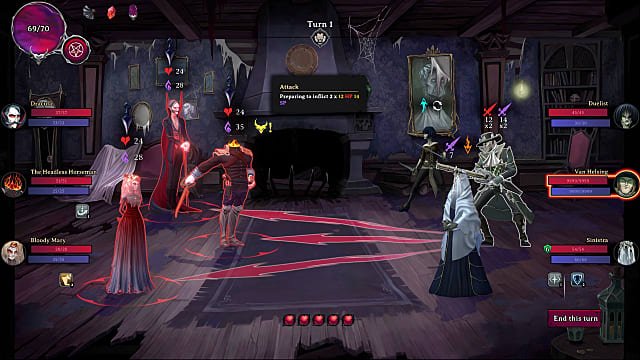A new card game that takes you on a journey through the ages of Dark Age Mythology. It’s up to you, the Rogue Lords, to defeat evil and reclaim your world’s throne!
The “rogue lords walkthrough” is a review of the game, Rogue Lords. The game was released in May 2018 and is available on Steam for PC and Xbox One.
I have a difficult connection with Cyanide, a French development company.
It’s not that their games are terrible – Call of Cthulhu, released in 2018, was at least playable — but they’re often odd, like game design from another planet. You comb through them rather than reviewing them in search of the black box.
Rogue Lords is no different. It joins other 2021 releases like Across the Obelisk, Griftlands, Black Book (kind of), and Roguebook in the increasingly crowded “indie roguelike/card game” category. We should probably start calling them “Spirelikes” at some point.
Rogue Lords, like the other Cyanide games I’ve seen, has that peculiar mix of strange choices, overcomplication, and lack of polish that is often referred to as “Eurojank.” Again, games with a lot of Eurojank aren’t always bad – Gamedec is Eurojank to the core — but they’re usually strange. Rogue Lords has a lot of things I enjoy, but it also has a lot of things I don’t understand.
Review of Rogue Lords: Make Way for the Bad Guys
So, in this case, you’re the Devil. Halloween greetings.
You and your public-domain horror minions lost the ultimate fight between good and evil decades ago, and you holed up in Hell for as long as you could to recuperate. After a few years, the flow of souls to Hell has slowed to a crawl, so you have no option but to return and investigate.
It turns out that the demon hunters who exiled you founded a new church called the Sancta Lumen, which is led by your archenemy Van Helsing. The forces of good are tightening their grip on the situation.
You must now assemble your final few remaining followers – Dracula, the Headless Horseman, and Bloody Mary — and dispatch them in quest of different surviving evil relics.
What I like about it is that it’s not what I expected it to be, which is some kind of Dragonlance Kingpriest of Istar thing where good and evil must be kept in cosmic balance or terrible things would happen. The Devil of the Rogue Lords lacks any redeeming features. He’s a cackling cartoon villain who wants to stay that way, and he’ll kill hundreds to make sure he gets his way.
Depression has been weaponized.
Rogue Lords isn’t difficult to learn, although it does come off as too complex at times.
You may send out a team of up to three monsters into the field to find each required item. Each chapter of gameplay includes a randomized area filled with battles, minibosses, encounters, riches, and possible bonuses, all of which must be properly balanced. Elite encounters are difficult even early on, but defeating one may net you a valuable relic.
You may use up to five abilities per character at first, paying their prices from a beginning energy pool of five. When you use a talent, it becomes “drained,” but each character has a base active ability that you may use on your turn to replenish their current skill pool.
Rogue Lords handles abilities in the same manner as other games do with cards; they aren’t completely interchangeable, but they’re close.
Your characters’ non-combat attributes, such as Stealth, Occultism, and Ruse, determine their chances of success in different non-combat situations. Success there may lead to passive benefits for the remainder of the level, such as increased health or minor damage increases, so they’re worth looking for, as well as being darkly amusing in their own right.

The fact that every character in Rogue Lords has what amounts to two health bars: HP and SP, takes some getting accustomed to. When any of these stats is depleted to zero, a character becomes susceptible. If you strike the decreased stat one more time, the character will be knocked out.
Because a character can’t be reduced to 0 HP/SP with a single large hit, the need for that final hit opens the door to some really terrible strats. It makes multi-hit strikes (such as Dracula’s Midnight Kiss) very beneficial, and it drastically alters how you respond to enemy attacks.
A large bruiser who hits for 50+ damage each strike isn’t always as deadly as a little bruiser who hits three times every round.
These two health bars are supposed to push you to maintain a diverse repertoire of moves. HP is a measure of physical health, while SP is a measure of mental toughness. Many opponents will consistently have much less of one than the other, and barring a few skill synergies, there’s seldom any need to reduce both HP and SP at the same time.
In reality, I didn’t go far in Rogue Lords until I was able to put together a solid SP-targeting build, mainly because Depression is a status condition that is completely broken. It deals SP damage to a victim just before and after they do an action, similar to a poison or bleed effect but better.
It felt like I’d disconnected Rogue Lords’ parking brake once I got a handful of abilities on Bloody Mary that could strike a whole opposing party with Depression. From hell to breakfast, I was leaving a path of depressed corpses. I succeeded in making a group of unfortunate Sancta Lumen rank-and-file Sancta Lumen so depressed that they perished.
Details are the Devil’s Work

Another habit I had to break before I felt like I understood Rogue Lords is that it isn’t concerned with general resource conservation as much as many other recent roguelikes. Your characters start each battle with full HP/SP and all of their abilities are recharged between fights, allowing you to go all out against each new wave of opponents.
Outside the basic money, the only resource you have to manage is diabolic essence, which is located in the top left-hand corner of the screen. If one of your characters falls down during a battle, you must spend diabolic essence to get them back up and fighting.
The secret is that you can cheat in virtually every aspect of the game by using diabolic essence. You may use essence to heal your characters, harm your opponents, and transfer status effects from one character to another during battle. You may spend essence outside of battle to improve the chances of a particular action succeeding by tweaking skill tests in random encounters.
Even if you do something crazy like reducing an elite enemy’s HP to zero, each use of essence is shockingly inexpensive, yet it’s tough to refill in the field. It’s all too simple to get carried away with your essence a few times too many, then start a routine battle that results in an unexpected game over.
This is a common occurrence. The lack of elegance in how Rogue Lords delivers information to the user is the most Eurojanky aspect of the game. It, like Black Book, has a strong desire to keep adding additional complexities to battle, such as new buffs and debuffs, while also having a cluttered UI that makes it difficult to get meaningful information at a glance. My Dracula was capped at 1 SP the whole time during a boss battle, and I have no clue why.
In contrast to other games in its genre, it also has an odd sense of time. Rogue Lords has an introduction level and six major stages that make up the game’s campaign. Even if you have an overpowering build and are very definite about your selections, each of the latter phases may take a couple of hours to accomplish.
One of the things I enjoy about “Spirelikes” — I’m calling them that — is how little they are, how quickly they move and how little time they require to play. Rogue Lords mixes a real time commitment with a significant probability of random, unexpected failure.
The Bottom Line in Rogue Lords Review
Pros:
-
As a gaming mechanic, cheating
-
A fantastic Halloween game with plenty of atmosphere and joyful wickedness.
-
The animation and character designs are a lot of fun.
-
It has reached maximal, near-toxic Goth levels.
-
It’s good once it clicks.
Cons:
-
It may take some time for it to click, however.
-
It doesn’t seem to value your time.
-
The difficulty curve is very uneven.
-
UI that is cluttered
-
Dracula is essentially an unavoidable party member.
I was probably carrying a chip on my shoulder after seeing Cyanide’s name on Rogue Lords. It finally won me over with its Tales From the Crypt vibe, which allowed me to play it long enough to figure out how to make it work.
It’s still a game with major flaws. Rogue Lords needs a great deal more polish before I can suggest it. The UI is disorganized, the pace is wrong, and the game makes it tough to get into by presenting overly complex concepts in cryptic, difficult-to-understand ways.
I like the ambience and the joy it takes in allowing you to be wicked, but if I weren’t reviewing it, I would have abandoned Rogue Lords within the first hour. If you can get through it, there’s a lot of fun to be had here, but it doesn’t seem completed like a lot other Eurojank games.
[Note: The copy of Rogue Lords used for this review was supplied by Nacon.]
The “rogue lords guide” is a book that reviews the various villains in Dungeons and Dragons. The book was written by an author who has been playing D&D for over 20 years.
Related Tags
- rogue lords unlock characters
- rogue lords | disciples
- rogue lords wiki
- rogue lords gameplay
- rogue lords steam

